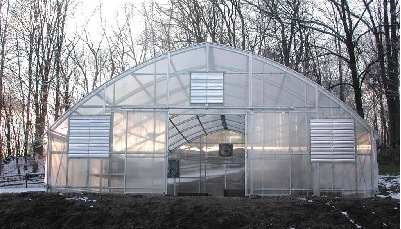In our last blog, we discussed the benefits of greenhouse agriculture versus the cost issues of providing artificial heat and light in Controlled Environment Agriculture (CEA). Here, we’ll explore some alternative approaches that are making greenhouse agriculture a vital component of sustainable food production around the world.
Heat is an important factor for successful greenhouses in cold climates—if the soil is too cold, seedlings won’t sprout. If the temperature of the air is too low, cold injury ranging from blossom loss to the death of the plant will result. Aside from conscientious weatherproofing to prevent heat loss, what can be done to keep a greenhouse toasty when the temperature outside is below freezing, without overwhelming costs in both currency and carbon footprint?
 Walpinis, or underground greenhouses or pit gardens, utilize the constant temperature underground to keep a steady growing season in less than favorable climates. They can be built much less expensively than a “traditional” greenhouse, and aren’t as susceptible to damage from wind or hail.
In the simplest solar thermal greenhouses, thermal mass such as stones, cement and water are positioned to capture solar energy during the day and radiate it back at night. Earth-sheltered or pit greenhouses, take advantage of the constant temperature of soil several feet underground. Their design allows the sun in for natural lighting while providing substantial insulation that reduces the need for supplemental heat.
In more complex solar greenhouses, an active system concentrates solar energy and converts it to electricity, which then moves warm water in pipes throughout the greenhouse to act as heat exchangers.
Solar PV panels require no fuel and have no moving parts, so they are easier to operate and maintain than diesel or gasoline generators. They can provide energy for supplemental heat and lights, and can power water pumps, ventilators and irrigation systems without issues of carbon emissions and sustainability.
There are still other energy sources for greenhouses, such as geothermal heat, that can be used for passive or active heating or for direct power generation, depending on the temperature of the source. In the case of some low temperature designs, the same system can even be used to cool the greenhouse in warmer months.
Walpinis, or underground greenhouses or pit gardens, utilize the constant temperature underground to keep a steady growing season in less than favorable climates. They can be built much less expensively than a “traditional” greenhouse, and aren’t as susceptible to damage from wind or hail.
In the simplest solar thermal greenhouses, thermal mass such as stones, cement and water are positioned to capture solar energy during the day and radiate it back at night. Earth-sheltered or pit greenhouses, take advantage of the constant temperature of soil several feet underground. Their design allows the sun in for natural lighting while providing substantial insulation that reduces the need for supplemental heat.
In more complex solar greenhouses, an active system concentrates solar energy and converts it to electricity, which then moves warm water in pipes throughout the greenhouse to act as heat exchangers.
Solar PV panels require no fuel and have no moving parts, so they are easier to operate and maintain than diesel or gasoline generators. They can provide energy for supplemental heat and lights, and can power water pumps, ventilators and irrigation systems without issues of carbon emissions and sustainability.
There are still other energy sources for greenhouses, such as geothermal heat, that can be used for passive or active heating or for direct power generation, depending on the temperature of the source. In the case of some low temperature designs, the same system can even be used to cool the greenhouse in warmer months.
 These alternative energy sources are available today and are steadily decreasing in price. Considering the recent volatility in prices for fossil fuels and the focus on renewable energy sources, use of alternative energy is increasingly attractive, particularly in the long term. Aside from maintenance, once a solar or geothermal installation is paid for, it provides power without the endless need to purchase fuel for a carbon-based system.
In the end, with the right approach to greenhouse design and use of renewable energy sources, the net benefits of both CEA and MEA can be substantial and far outweigh the costs of most current production methods.
For information on BTL Liners’ custom fabricated BTL-8 and BTL-12 clear greenhouse covers, please call us at 541-447-0712.
These alternative energy sources are available today and are steadily decreasing in price. Considering the recent volatility in prices for fossil fuels and the focus on renewable energy sources, use of alternative energy is increasingly attractive, particularly in the long term. Aside from maintenance, once a solar or geothermal installation is paid for, it provides power without the endless need to purchase fuel for a carbon-based system.
In the end, with the right approach to greenhouse design and use of renewable energy sources, the net benefits of both CEA and MEA can be substantial and far outweigh the costs of most current production methods.
For information on BTL Liners’ custom fabricated BTL-8 and BTL-12 clear greenhouse covers, please call us at 541-447-0712.



